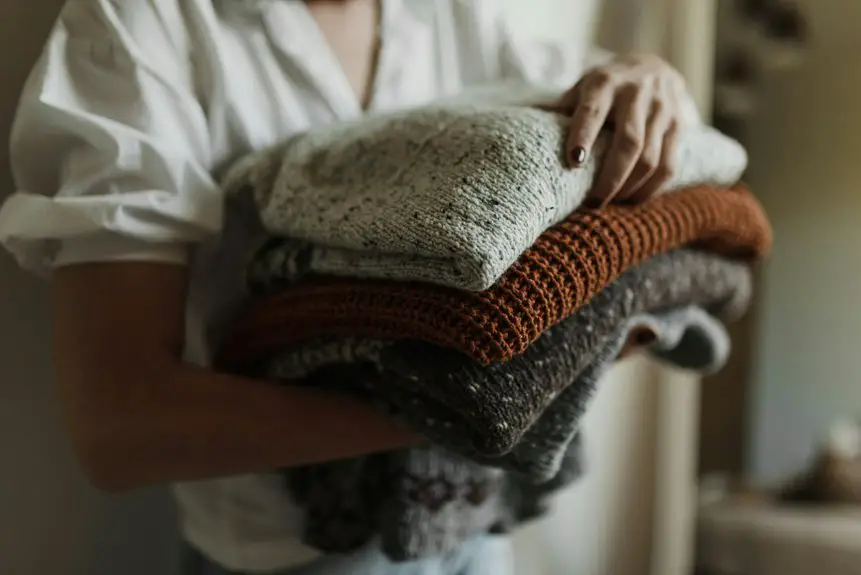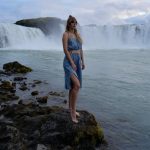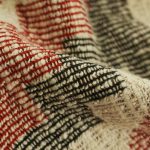When it comes to staying warm in cold weather, the choice of base layer fabric can make a significant difference. You’ve likely heard about various materials, but do you know which ones truly excel in insulation and moisture management? Understanding the strengths and weaknesses of options like merino wool and synthetic fibers can be vital for your comfort. Let’s explore the best fabrics that can help you tackle those chilly days effectively.
Table of Contents
Key Takeaways
- Merino wool provides exceptional insulation, breathability, and moisture-wicking, keeping you comfortable in cold weather.
- Synthetic fibers offer quick-drying properties and moisture management, making them ideal for active outdoor pursuits.
- Wool blends combine the benefits of natural wool with synthetic durability, ensuring warmth and comfort at a more affordable price.
- Bamboo is a soft, breathable, and eco-friendly option that effectively regulates temperature and wicks moisture away from the skin.
- Silk delivers luxurious comfort and natural temperature regulation, but requires careful washing to maintain its quality.
Merino Wool: The Gold Standard for Warmth and Moisture Management
When it comes to staying warm in cold weather, merino wool stands out as the gold standard for base layers. Its natural fibers provide unmatched insulation, trapping heat close to your body while remaining breathable.
You won’t have to worry about moisture, either—merino wool effectively wicks sweat away, keeping you dry and comfortable throughout your activities. Unlike synthetic materials, it’s also odor-resistant, so you can wear it multiple days without feeling self-conscious.
Plus, merino wool is lightweight and soft against your skin, making it ideal for layering. Whether you’re skiing, hiking, or just enjoying a chilly day outside, investing in a merino wool base layer guarantees you’ll stay warm, dry, and ready for any adventure.
Synthetic Fibers: Versatile and Quick-Drying Solutions
Although merino wool is often praised for its warmth, synthetic fibers offer a versatile and quick-drying alternative that caters to a variety of outdoor activities.
These materials, such as polyester and nylon, excel at wicking moisture away from your skin, keeping you dry and comfortable during intense workouts. They’re lightweight and packable, making them perfect for layering under heavier clothing.
Synthetic fibers also resist odors and dry faster than natural fabrics, enhancing your overall experience in cold weather. They can handle sweat and humidity, ensuring you stay warm without feeling clammy.
Plus, they come in various styles and fits, allowing you to choose the perfect base layer for your needs. Embrace synthetic options for reliable and efficient cold weather performance.
Wool Blends: Combining Durability With Affordability
Wool blends offer a fantastic balance between durability and affordability, making them an excellent choice for your cold weather base layers.
Wool blends strike the perfect balance of durability and affordability for your essential cold weather base layers.
These fabrics often combine wool with synthetic fibers, enhancing their strength while keeping costs down. You’ll find that wool’s natural insulation and moisture-wicking properties keep you warm and dry, even during vigorous activities.
The added synthetic fibers improve stretch and durability, ensuring your base layers withstand regular wear and tear. Plus, wool blends are typically softer against your skin, reducing irritation during long days outdoors.
When shopping, look for blends that feature a higher percentage of wool for ideal warmth without sacrificing comfort or your budget. You’ll appreciate the performance and longevity these materials provide.
Bamboo: A Breathable Alternative for Base Layers
Bamboo fabric stands out as a breathable alternative for base layers, especially in cold weather. It offers several benefits that enhance your comfort during chilly outdoor activities:
- Moisture-Wicking: Bamboo naturally pulls moisture away from your skin, keeping you dry and warm.
- Thermal Regulation: This fabric helps maintain a stable body temperature, allowing you to stay comfortable in varying conditions.
- Softness: Bamboo is incredibly soft against the skin, reducing chafing and irritation during long wear.
- Eco-Friendly: As a renewable resource, bamboo is a sustainable choice, making it good for you and the planet.
Choosing bamboo for your base layers means enjoying warmth without compromising breathability.
Silk: Luxurious yet Costly Cold Weather Option
Silk is a luxurious option for base layers in cold weather, offering unparalleled comfort and warmth. Its smooth texture feels incredible against your skin, making those chilly days more bearable.
Silk’s natural temperature-regulating properties keep you cozy without causing overheating, so you can stay comfortable during various activities. However, it comes with a higher price tag compared to other fabrics, which might be a consideration if you’re on a budget.
Despite the cost, many find that the benefits outweigh the expense, especially for those seeking premium comfort. Just remember to care for your silk layers properly; they require delicate washing to maintain their quality.
If you’re willing to invest, silk can be a fantastic addition to your cold-weather wardrobe.
Performance Features: What to Look for in Base Layer Fabrics
When choosing the right base layer fabrics for cold weather, what should you prioritize?
You need to look for specific performance features that enhance your comfort and warmth.
Here are four key aspects to evaluate:
- Moisture-Wicking: Fabrics that draw sweat away from your skin keep you dry and warm.
- Insulation: Look for materials that trap heat, providing an extra layer of warmth without bulk.
- Breathability: Choose fabrics that allow air circulation, preventing overheating during high-intensity activities.
- Odor Resistance: Select options treated to combat odor, so you can stay fresh even after long wear.
Fit and Mobility: Ensuring Comfort in Extreme Conditions
When it comes to base layers, finding the right fit is essential for your comfort in extreme conditions.
A snug fit can keep warmth close to your body, while a looser fit might allow for better mobility during high-intensity activities.
Consider your specific activities to choose the fit that best supports your performance and comfort.
Snug vs. Loose Fit
Finding the right fit for your base layer can make all the difference in extreme cold conditions. You’ll want to reflect on whether a snug or loose fit works best for you. A snug fit helps trap warmth and wick moisture away, while a loose fit allows for better airflow and freedom of movement.
Here are some factors to keep in mind:
- Insulation: Snug layers provide better insulation by hugging your body.
- Moisture Management: A snug fit can effectively wick sweat, keeping you dry.
- Layering: Loose fits might work better when layering with other garments.
- Comfort: Choose what feels comfortable and allows for mobility, especially during activities.
Ultimately, it’s about balancing warmth and flexibility.
Activity-Specific Considerations
While engaging in outdoor activities in frigid temperatures, it’s essential to contemplate how your base layer impacts both fit and mobility. A good fit allows for freedom of movement, vital for activities like skiing or climbing, while ensuring warmth without bulk.
| Activity | Ideal Fit | Key Feature |
|---|---|---|
| Skiing | Snug | Compression for warmth |
| Snowshoeing | Loose | Breathable for movement |
| Climbing | Snug | Stretch for flexibility |
| Hiking | Semi-Fit | Moisture-wicking properties |
| Running | Snug | Lightweight for agility |
Choosing the right fit tailored to your activity can greatly enhance your comfort and performance in extreme conditions. Make sure your base layer supports your movements effectively.
Frequently Asked Questions
How Do I Choose the Right Thickness for My Base Layer?
When choosing thickness for your base layer, consider the temperature and activity level. Thinner layers offer breathability for high-intensity activities, while thicker options provide insulation for colder conditions. Match your choice to your adventure’s demands.
Can I Wear Base Layers in Warmer Weather Conditions?
Sure, you can wear base layers in warmer weather! Just imagine sweating like a popsicle left in the sun. But lightweight, moisture-wicking options can keep you comfortable, so you won’t melt away in the heat!
Are There Eco-Friendly Base Layer Fabric Options Available?
Yes, there’re eco-friendly base layer options available. Look for fabrics made from organic cotton, bamboo, or recycled materials. These choices not only keep you comfortable but also help reduce your environmental impact while enjoying outdoor activities.
How Often Should I Wash My Base Layers?
You should wash your base layers after every use, especially if they’re sweaty or soiled. Regular washing helps maintain their performance and odor control, ensuring you stay comfortable and fresh during your outdoor activities.
What Are the Best Color Options for Base Layers in Cold Weather?
Imagine a snowy landscape where deep navy, forest green, or vibrant red base layers contrast against the white. These colors not only keep you stylish but also provide a psychological boost on chilly adventures.
- Is Crepe Fabric Sustainable? A Look at Eco-Friendly Options - June 23, 2025
- Understanding Fabric Weight: How to Choose the Right Crepe for Your Project - June 23, 2025
- Is Crepe Fabric Expensive? A Price Breakdown by Fiber Type - June 23, 2025







